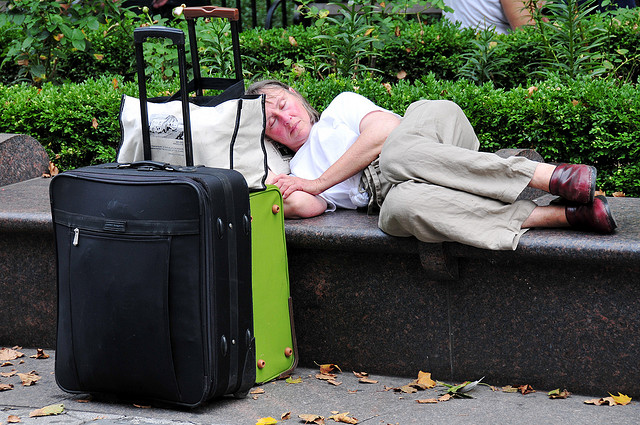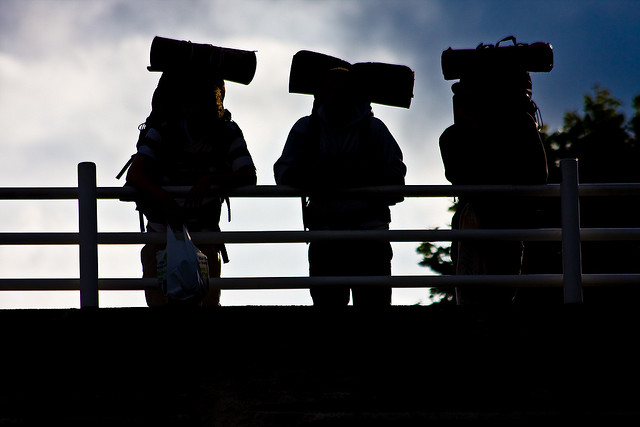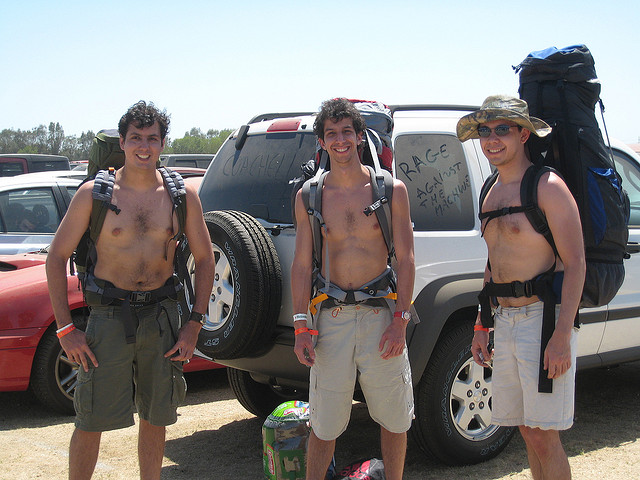
Long-term travelers have a few basic options when it comes to their bags – backpacks, suitcases, or hybrids.
The backpack is the typical piece of gear for vagabonding travelers. The main reason behind this is because most long trips involve travel in developing countries, where roads are worse and sidewalks sometimes non-existent. I can’t imagine rolling a suitcase through the streets of Hanoi. That being said, don’t get a backpack just because most others do. Like anything involving this trip, you have to decide what’s best for you! If you have a bad back and a backpack aggravates it, then look at one of your other options. If you just prefer a suitcase and understand the negative aspects of bringing one, that’s what matters.
If you have kids and are traveling with them, then the situation becomes more complicated based on your children’s ages and size. It’s essential to be realistic about what each child is able to carry. Having a strategy is a must for traveling families.
Suitcases

Some people just like suitcases. They do tend to be easier to pack and unpack and keep organized, and if you can manage to pack light and bring a small one, getting around those areas where rolling a bag may be difficult is a moot point. If your bag only weighs 20 pounds, it’s not too hard to just pick it up and carry it along that dirt road, cobblestone street, or up 4 flights of stairs.
The problems come when people use the biggest suitcase they can find and cram it full with 60 pounds worth of stuff, though the same problem arises with a hybrid bag or a backpack. Packing light is advisable no matter what type of bag you bring.
A few things to ask yourself before settling on a suitcase:
- Do you plan on doing any hiking or trekking? If so, a backpack of some kind will be necessary.
- Do you plan on bringing a secondary bag for things like electronics? If so, could this double as a day pack for exploring cities and going on hikes?
- Will you visit a lot of developing countries and stay in hostels where elevators are not the norm?
- Will you be taking a lot of public transport and traveling overland?
If you do go the suitcase route, check out all options. Suitcases come in all different shapes and sizes with many different features, so do your homework. Even though you’ll hear from most people that a suitcase is not right for this type of trip, it all depends on your trip. If you are flying a lot, staying in large cities, not doing much in the way of outdoor activities, or you simply like suitcases better, then bring one!
Hybrids
If you just prefer suitcases to backpacks, have you looked into hybrids? A hybrid is a combination of a backpack and suitcase – it can usually be rolled like a suitcase but has shoulder (and sometimes hip) straps to allow you to strap it on during those times when rolling it is difficult.
A few things to keep in mind and ask yourself when trying to decide on a hybrid vs. a backpack:
- Though it has shoulder straps, and often straps to go around your waist, they aren’t typically as padded or supportive as a good backpack.
- A hybrid is not good for hiking and trekking. As stated above, they don’t adequate support and are often heavy.
- Are you a light packer? If so, a hybrid may be perfect for you as the above limitations won’t matter if your pack is small and light.
Shopping around and choosing the right hybrid bag for you is important, and it’s necessary to head out to your nearest outdoor store, talk to an expert, and try many of them on. Spend some time there, add weight to it, and walk around the store. Practice rolling it behind you, quickly throwing it on your back and head up a flight of stairs. Try to simulate a real travel situation as much as you can.
Backpacks

If you go the backpack route like most others, you’re going to want it to be perfect. If your backpack is too big or too small, not padded enough, or poorly designed for your tastes, it can seriously put a damper on your trip.
When choosing a backpack for a RTW trip, you’re going to want to consider four things: size, weight, comfort, and design.
Size
The size of your pack will be dependent on several things. Climates you are visiting, whether you plan on doing any hiking or trekking, your size and body type, and if you plan on checking or carrying on are all big factors.
Climate
If you are following summer around the world or only going to warmer, tropical climates, you have a lot more wiggle room simply because you won’t have to bring as many layers, and the clothes you do bring will be smaller.
We spent some time in some colder areas, but not winter, so no heavy coats were necessary. But we did both have jackets, fleeces, and several layers for hiking in the Andes, Patagonia, and visiting New Zealand in the fall. Though it could have been done with only carry-ons, it would have been challenging and really would have restricted what we brought.
Hiking and trekking
If you plan on doing any multi-day hikes or treks, then you want a pack that’s appropriate. You may not be able to get by with a carry-on sized pack simply because it won’t be adequate for the activities you want to take part in.
Multi-day hikes typically require you to bring things like tents, sleeping bags, and food, and though you can get by with a few layers, the other stuff takes up a lot of room, so fitting it all in a 35 liter pack is tough.
Your size
How big or small you are will also have an impact on the size of your pack. I was constantly amazed to see women who were just over 5 feet tall and not much more than 115 pounds struggling to carry packs that were almost as big as they were. If you are a smaller person, then please don’t get a 90 liter pack that you can barely get on your back yourself. Use some common sense when shopping, make sure to put plenty of weight in the pack when trying them on, and walk around the store. Go up and down stairs with it fully loaded to see how it feels. If you get tired and start sweating after walking around an air conditioned store for 10 minutes, think of how it’s going to be navigating the streets of Delhi in 110 degree heat with a billion other people around you.
Carrying on
If you carry on, you won’t be able to get away with anything bigger than around a 45 liter pack. Make sure you check the dimensions of your pack against carry-on restrictions if you’re going this route. Round the world travelers can get away with a pack that’s 35-45 liters, but you’ll have to be extremely particular with your packing list.
Keep in mind that if you do go the carry-on only route, you’ll be highly restricted on what you can bring. That means no liquids more than 3 ounces and no sharp tools like a Leatherman or Swiss Army Knife. Keep this in mind when making your decision.
Though I brought a pretty large pack (70 liters) on my RTW trip, I have since downsized to a smaller, 40 liter pack which I can carry on. I’ve been to New York City in the winter for a week, Europe in the fall for 3 weeks, and Central America in the summer for 2.5 weeks with this smaller pack. I pack the same amount of clothing despite the length of the trip, and though I love my larger pack, it’s now reserved for outdoor backpacking trips and road trips. The smaller one will be my go-to, even for our next big adventure.
After being frustrated at not being able to find the perfect pack, friend of BootsnAll Fred Perrotta decided to design his own. Check out the Tortuga Travel Backpack to find out more.
Checking

If you do plan on checking your bag, that doesn’t mean you should go with an 80 or 90 liter pack. Less is almost always better, and even though we preach packing less, that doesn’t mean you need to be a total minimalist. As someone who has been on a one-year round the world, in addition to several 2 and 3 week long trips abroad, I usually bring the same sized bag regardless. I pack enough clothes for about a week and plan on doing laundry if I’m gone longer than that, whether it’s two weeks or one year.
The bigger the bag means that you will pack more stuff, which means more weight on your back. My best advice for choosing the right sized pack is to find the most comfortable pack, no more than 70 liters, with the features that you want.
The 70 liter pack I brought on our RTW trip was more than enough. It was never packed full, which I think is essential if you go with a pack that big. It never felt overwhelming to me (I’m a short guy – 5’9″). I also traveled with my wife, so we shared packing duties. She brought a much smaller, 42 liter pack, which she could carry on airplanes. It was nice to be able to check one bag between us, though, so we weren’t restricted on liquids and things like our Leatherman (or a Swiss Army Knife).
This is especially true if you’re a traveling family. Even if you all manage to bring smaller packs with you, you may want to think about checking one bag between your family just so you aren’t so restricted with what you can and can’t bring. Take advantage of the fact that you can share packing duties between the entire family – don’t look at it as a negative.
Weight
Lighter is almost always better. You don’t want a backpack that weighs 10 pounds in and of itself. That will put you behind the 8-ball immediately when it comes to how much stuff you can bring.
Comfort
Comfort is the most important factor in selecting a pack, in my opinion. I bought my 70 liter pack (a Gregory Reality – this particular model has since been discontinued) back in 2002 for a backpacking trip into the Grand Canyon. Because it was bought for a multi-day trek, I focused on quality and comfort above all else. It fit me perfectly and was just a good, solid pack. It went with me on several road trips and hikes after that initial trip, then on our RTW trip in 08-09, and it’s still going strong 15 years later. While you may suffer from sticker shock when first looking at packs, it’s important to know that you get what you pay for. The good ones are extremely durable (again, I’ve had mine for 15 years now, including bringing it on our year-long RTW).
You’re going to be lugging this bag all over the world, so it needs to be darned comfortable. I strongly suggest that you measure your torso and try on a ton of different packs that fit your torso size. Look for packs with padded straps and back panels as well as designs that promote air flow. Make sure to try on the pack fully loaded so you will know that the pack will fit comfortably regardless of how much gear you are carrying.
Also, women’s specific backpacks are great for smaller bodies (including kids). There are obviously kid specific packs as well, and many women’s packs have adjustable straps for different torso sizes, great for growing kids. If you’re bringing a 12-year-old on a year-long RTW trip, chances are he or she will change pretty dramatically from a physical standpoint over the course of a year – something to keep in mind when choosing your pack.
Design
Hopefully you will find several packs that are both comfortable and fit your size and weight specifications, so you can choose the best pack for you based on design and features. Look for bags with lots of pockets so you can keep organized on the road. Top loading only bags can be infuriating. Make sure it has front access zippers so you don’t have to take everything out of your pack to get something out of the bottom of your pack. You may also want to choose a pack that is made from water-resistant fabrics or has a built-in rain cover if you are headed to humid climates. Check the quality of the zippers and seams. If they look cheap now, think of how they’ll hold up after zipping and unzipping several thousand times over the course of your trip.
Since I’ve referenced all three so often in this article, here are the two backpacks my wife and I brought on our RTW, followed by my newer, carry-on only pack that I’ve brought as my primary bag on several international trips since our RTW. I’ve since bought a new pack – a Tortuga – that is designed specifically for carry-on travel and light packers. It’s an awesome pack that I love. The only downfall is that while it does have comfortable shoulder straps and a waist strap, I’m not sure how great it would be for hiking.
Secondary bag(s)
Unless you are a total minimalist, most travelers pack a smaller, secondary bag. These range from smaller daypacks to large purses to sling bags. What you choose to bring will depend on your personal situation – like how many and which gadgets you bring with you and if you are traveling with anyone else.
If you are traveling with a friend, spouse, significant other, or family, you can share packing duties, so even if you are bringing a larger, DSLR camera and laptop, you are probably only bringing one each, so it makes how many and which type of bag to bring easier.
If you are traveling solo, you will have to make some tougher decisions on how much to bring since you only have yourself to rely on for carrying. If you have a traveling family, it could be easier or more difficult depending on how old and big your children are. Obviously if you have smaller children, you’re going to carry a lot of their stuff (though on the plus side, their stuff is small and light).
We went with a smaller backpack that was then used as a daypack throughout the trip. We also brought a Pacsafe bag that I think is a Godsend. It’s super durable and reliable, has some very cool anti-theft features, and I think is the perfect little size. We would use this as our “city bag” when walking around cities. It fit our DSLR camera in it, a book or two, jacket(s) or fleece(s), and some water.
When traveling on a bus or train, we always threw our larger packs with our clothes and toiletries underneath and kept our small backpack and Pacsafe bag with us at all times. Those had our expensive items – laptop, cameras, iPods, etc.
Check out our recommended travel gear page to see what types of backpacks we carry.
Photo credits: Ed Yourdon, garryknight, Thiago Hirai